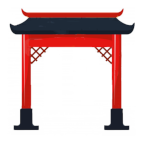| Meaning |

spoon, ladle 匕
|
| Explanation |
This character means: Spoon. - In the explanations it is typically used as a sitting person. (Further radicals with „person“ are: sitting cross-legged 夂, lying  , kneeling ⺈, skilled 才, bending マ,卩, slumped 㔾 or husband 夫) , kneeling ⺈, skilled 才, bending マ,卩, slumped 㔾 or husband 夫)
|
Used in these characters:
|
|
能
|
 |
|
JLPT HSK 1 |
|
| talent, ability, capability
|
Left: nose 厶, body 肉/月, right: claws 匕/匕
(In dog breeding:) Nose, body and claws prove talent.

|
|
|
|
些
|
 |
|
JLPT HSK 1 |
|
| some, few, several, small amount
|
Top: this/these 此 (He stopped 止 and sat 匕 down: This person!), below: two 二
These two are some, ..

|
|
|
|
老
|
 |
|
JLPT HSK 1 |
|
| aged/old (of people), venerable, experienced
|
Top: old man 耂, below: sitting person 匕
The old man sitting there is aged and experienced.

|
|
|
|
北
|
 |
|
JLPT HSK 1 |
|
| north
|
Two persons 丬, 匕 sit back-to-back, because they feel cold: in the north.

|
|
|
|
呢
|
 |
|
JLPT HSK 1 |
|
| End-particle: "What about...?", "And...?", "okay?"
|
Left: Mouth 口, right: buddhist nun 尼 (buttocks from side 尸, to sit 匕)
May the mouth of a Buddhist nun (talk)? ..and what about?

|
|
|
|
比
|
 |
|
JLPT HSK 2 |
|
| to compare, to contrast, gesture with hands, Belgium
|
Sitting persons 匕匕
There are two sitting persons: Compare them.

|
|
|
|
它
|
 |
|
JLPT HSK 2 |
|
| it, (used for lifeless things)
|
Top: roof 宀, below: ladle/spoon 匕
Under the roof the ladle is a lifeless thing, an "it".

|
|
|
|
化
|
 |
|
JLPT HSK 3 |
|
| change, transform, to make into
|
Left: standing person 亻, right: ladle/spoon 匕 (here: sitting person),
If a standing person becomes a sitting person, it is a change.

|
|
|
|
熊
|
 |
|
JLPT HSK 3 |
|
| bear, raging flames
|
Top: talent, ability 能 (nose 厶, body 月/肉 and claws 匕匕 prove talent.), bottom: four legs 灬
The 'talent' on four legs is the bear.

|
|
|
|
论
|
 |
|
JLPT HSK 4 |
|
| discuss, to comment on, theory, to evaluate
|
Left: word 讠/言 (sound waves out of a mouth 口), right: set up, arrange 仑 (When a person 人 turns into a sitting person 匕, it is well arranged.) - Here: a person over another
Words whether persons can be above other persons are in this discussion.

|
|
|
|
此
|
 |
|
JLPT HSK 4 |
|
| this, these
|
Left: stop 止 (footprint of a right foot that stops at a line 一), right: sitting person 匕
He stopped and sat down: This person.

|
|
|
|
死
|
 |
|
JLPT HSK 4 |
|
| to die, impassable, inflexible
|
bad, wicked 歹 (= vertebrae or rib) and sitting person 匕 under the ground 一
When the bones of the sitting person are under the earth, this means: to die.

|
|
|
|
匙
|
 |
|
JLPT HSK 4 |
|
| spoon
|
Left: correct 是 (sun 日, variant of correct 正), right: spoon 匕 (sitting person and eating)
It is correct: this is a spoon.

|
|
|
|
指
|
 |
|
JLPT HSK 4 |
|
| finger, to point at or to, to indicate
|
Left: hand 扌, right: order, purpose, 旨 (sitting person 匕, sun 日)
The hand of a sitting person points at the sun with: its finger.

|
|
|
|
紫
|
 |
|
JLPT HSK 5 |
|
| purple, violet, amethyst
|
Top: this 此 (He stopped 止 and sat 匕 down: This person.), below: thread 糸
Stop at the sitting person with the threads in purple.

|
|
|
|
蛇
|
 |
|
JLPT HSK 5 |
|
| snake, serpent
|
Left: insect 虫 (The body 口 and the sting 厶 of an insect.), right: it (lifeless) 它 (roof 宀, sitting person 匕)
The 'insect' next to the house with the sitting person is: a snake.

|
|
|
|
倾
|
 |
|
JLPT HSK 6 |
|
| incline, to collapse, to overturn, to tend
|
Left: person 亻, right: short while ago, area size qǐng 顷 (sitting person 匕, page, (fore)head 页/頁 (=head 目 with shoulders 八 and eyebrows 一) Better left: change 化
If a person 亻turns to a sitting 匕 person, it's in the head, that is inclining.

|
|
|
|
泥
|
 |
|
JLPT HSK 6 |
|
| mud, clay, paste, pulp
|
Left: water 氵, right: nun 尼 (buttock from the side 尸, sitting person 匕)
The water, in which the nun is sitting, is muddy.

|
|
|
|
脂
|
 |
|
JLPT HSK 6 |
|
| fat, rouge (cosmetics), resin
|
Left: meat/body 月/肉, right: order, purpose 旨 (If sb. is sitting 匕 in sun 日 he has the purpose [to indicate with the fingers 指])
Meat/Flesh has been 'ordered' to contain: fat.

|
|
|
|
伦
|
 |
|
JLPT HSK 6 |
|
| coherence, human relationship, order
|
Left: person 亻, right: arrange, set up 仑 (When a person 人 turns into a sitting person 匕, it is well arranged.)
A person, who is "well arranged" thinks in terms of coherence and relationships.

|
|
|
|
颖
|
 |
|
JLPT HSK 6 |
|
| clever, gifted, new and original, head of grain
|
Top: a short while ago 顷 (sitting person 匕, head 页/頁), below left: rice plant 禾
At rice plant is (sits) the spike (= "the grain's head"), which is considered: "clever and gifted".

|
|
|
|
旨
|
 |
|
JLPT HSK 6 |
|
| order, purpose, aim, imperial decree
|
Top: sitting person 匕, bottom: sun 日
If sb. sits above the sun, he can issue orders and decrees.

|
|
|
|
顷
|
 |
|
JLPT no HSK |
|
| a little while ago, unit of area equal to 100 亩 or 6.67 hectares
|
Left: sitting person 匕, right: page,leaf, head 页/頁 (head 目 with shoulders 八 and eyebrows 一)
The sitting person has in his head the area of 6.7 hectares

|
|
|
|
尼
|
 |
|
JLPT no HSK |
|
| Buddhist nun, (often used in phonetic spellings)
|
Buttock from the side 尸, sitting person 匕
Sitting on her buttocks is the nun.

|
|
|
|
叱
|
 |
|
JLPT no HSK |
|
| to scold, shout at, to hoot at
|
Left: mouth 口, right: sitting person 匕
With his mouth wide open, he is sitting and scolding.

|
|
|
|
妮
|
 |
|
JLPT no HSK |
|
| girl, phonetic "ni" (in girl's name)
|
Left woman 女, right: Buddist nun 尼 (buttock from the side 尸, sitting person 匕)
A woman, sitting like a nun, is: a girl.

|
|
|
|
匕
|
 |
|
JLPT no HSK |
|
| dagger, ladle, ancient type of spoon
|
In the radicals often understood as: a sitting person
Image of a spoon.

|
|
|
|
仑
|
 |
|
JLPT no HSK |
|
| arrange, (mountain range in Xinjiang)
|
Top: person 人, bottom: sitting person 匕
When a person turns into a sitting person, it is well arranged.

|
|
|
| Radicals are shown here that are similar either in appearance or meaning. |  |
|
At the page you get the memory phrases for learning the Chinese Hanzi. If you are learning the Japanese kanji, please follow this link. |
List of the characters |
List of the radicals
|

 , kneeling ⺈, skilled 才, bending マ,卩, slumped 㔾 or husband 夫)
, kneeling ⺈, skilled 才, bending マ,卩, slumped 㔾 or husband 夫)